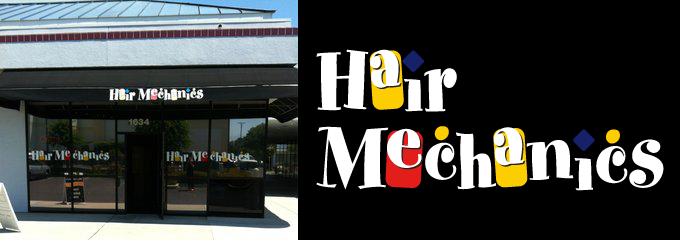Ariel Wilson runs a business in making people look and feel beautiful. She opened Hair Mechanics in 2002 and has since grown the business judiciously. She is currently rebranding the salon and expanding the team. As both a stylist and a businesswoman, Ariel is deeply invested in all aspects of Hair Mechanics, and hopes to inspire in her new team a similar pride of workmanship.
The Start
I was always interested in hair styling and make-up, but I didn’t always think of it as a career. I first studied art and worked as a substitute teacher. I applied to cosmetology school and once I got in I left my job. My parents weren’t happy; they have an old-school image of gum-chewing stylists with bouffant hair. After a year of cosmetology school I worked at a couple of salons. I got good experience, but there wasn’t enough room to grow, so I decided to start Hair Mechanics. Several of my co-workers followed me here; they’re still on the team. I had a friend who wanted to be a partner but I turned down the offer because I knew the profit margin would be too small.
Did you take on any funding in the beginning? Have you taken on additional funding since?
I took out an equity line. I needed a lot of money to renovate. I paid that off within the first four years and I haven’t needed any additional funding since.
Running the Business
How did you learn to run the business?
I learned from my parents. My mom is an accountant. My dad is self-employed and owns a bar and restaurant.
Who was your first customer?
A lot of clients followed me from the salons where I previously worked. The other stylists who joined my team also brought their own client base.
What is the smartest thing you did in the beginning?
Avoiding debt with a fancy over-the-top salon. I paid off my loans as soon as possible and I only make changes when I can afford it.
What was the biggest mistake you made in the beginning?
Managing the team. I should have cracked down more. I used to hire stylists under a rent/contracting system, which means they pay rent for a chair and manage their own clientele. The problem with the renting system is there is no pride of ownership, there’s no skin in the game, so the renters don’t take care of the salon or clean up after themselves. They don’t want to grow, they just want to keep their status quo, make their money and get out. So the salon had no standard; the client experience was inconsistent. One day customers might be greeted politely and another day they might come in to hear cussing and yelling.
What have been some of the biggest challenges of running your business?
The computer stuff is my nemesis. I avoided it as long as I could. It used to be the industry was just people. Marketing was just by word-of-mouth and referrals. But now it’s all about Yelp and Facebook business pages.
What has been the most rewarding part about running your business?
People are interesting to work with and it’s fun to make people look good and feel good. I get a real high doing something I enjoy and being able to make a living out of it.
What I’ve Learned
What knowledge do you wish you had before starting your business?
I would make sure to hire nice people. Right now I’m rebranding Hair Mechanics. I’m hiring new stylists by commission and I’m investing in an education program for them. With commission the sky’s the limit, your work reflects your income. This will bring the standards up.
I also avoided computers for a while, but now I’m setting up a computer program to keep track of the team. It will track their referrals, retention, retail sales. It will be useful to have the numbers; I’ll be able to see their strengths and weaknesses. This way I won’t have to guess when I’m doing promotions.
Do you have any advice for others starting in the this business?
Artists are not the best business people. I’ve heard that 1 in 5 stylists make it. My advice is if you want a career in styling, look at it as a career from the start. Hobbyists are fine, but even then you still need a profit margin. Some stylists give so much of a discount that when the numbers are added up they’re just going backwards. Realize you have to give discounts, but also keep in mind overhead costs. When you have a reason to charge more, charge more. You have to look at the numbers.
About the Author — Sarah is a recent graduate of UC Berkeley where she learned to love the diverse personalities of mom-and-pop stores. She likes intriguing storefronts, creative specialty stores, and well-designed business websites.
This article was originally written on October 7, 2014 and updated on July 12, 2016.


Have at it! We'd love to hear from you and encourage a lively discussion among our users. Please help us keep our site clean and protect yourself. Refrain from posting overtly promotional content, and avoid disclosing personal information such as bank account or phone numbers.
Reviews Disclosure: The responses below are not provided or commissioned by the credit card, financing and service companies that appear on this site. Responses have not been reviewed, approved or otherwise endorsed by the credit card, financing and service companies and it is not their responsibility to ensure all posts and/or questions are answered.